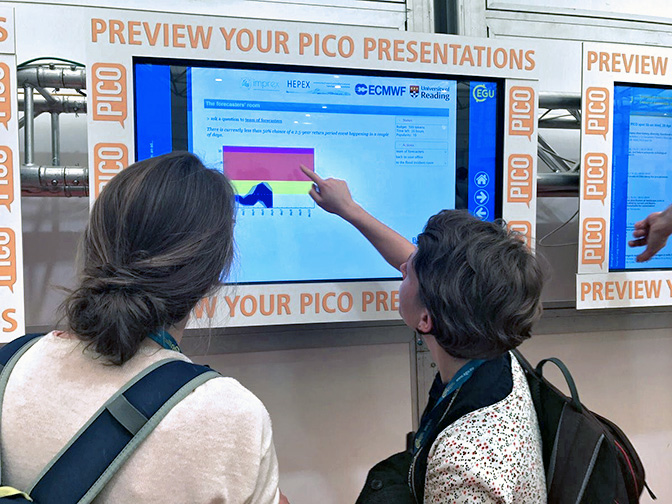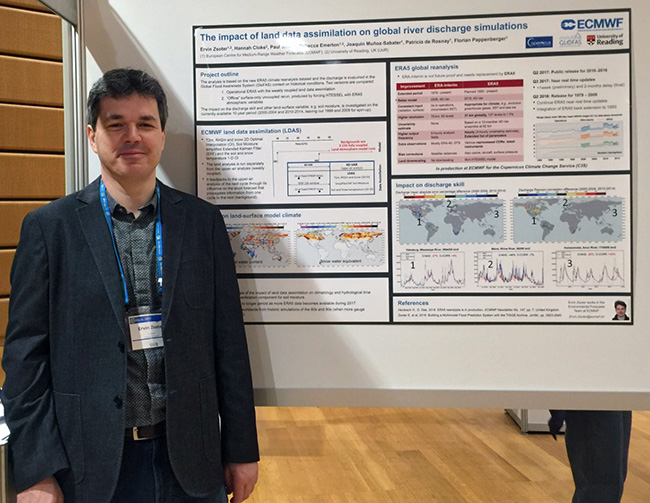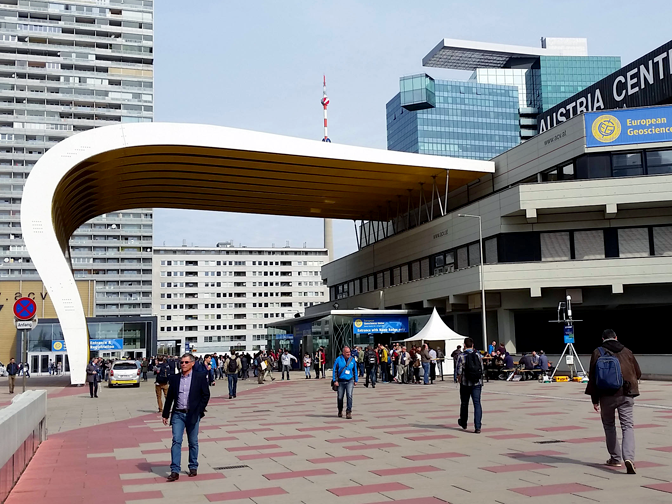

Numerical weather prediction featured prominently in talks about climate change and extreme events at the European Geosciences Union General Assembly in Vienna from 23 to 28 April 2017, according to ECMWF scientists who attended the conference.
“There are signs that numerical weather prediction and climate modelling increasingly engage with each other,” says Thomas Haiden, a veteran participant in the annual meeting, which this year attracted about 15,000 scientists from across the globe.
He cites the example of a session on 'Extreme events and impacts', in which climate change impacts were analysed in terms of concepts traditionally used in numerical weather prediction (NWP), such as atmospheric rivers, storm tracks, and blocking regimes.
“The entire floor space was occupied as the room was much too small for the many people from the two communities who wanted to attend.”
Talks given by the 13 ECMWF scientists attending the conference also reflected the relevance of NWP in a wider geosciences context.
They included presentations on flood, wave and fire forecasting, temperature predictability, the use of observations in Earth system modelling, atmospheric composition and big data.
Floods
Louise Arnal presented an online educational flood forecasting game she has co-developed with other partners in the IMPREX project and early career scientists.
The game aims to highlight the complexities of the decision-making process. It is a HEPEX community initiative and can be played online.
Louise also presented a poster on an improved seasonal river flow forecasting method.
“This method has the potential to be more skilful than the currently produced EFAS pan-European seasonal river flow forecasts, and more efficient to run,” she says.

David Lavers gave an interactive presentation in which he explained ECMWF’s Extreme Forecast Index for moisture fluxes.
Christel Prudhomme gave a solicited and highlighted talk on ‘Floods and Droughts: friends or foes’, summarising key research developments over the past 10 years.
She also co-convened two well-attended sessions, on ‘Drought and water scarcity’ and ‘From sub-seasonal forecasting to climate projections’.
Fredrik Wetterhall convened a well-attended session on ‘Ensemble hydro-meteorological forecasting’. One of the session talks was given by Rebecca Emerton, who presented a new GloFAS product currently in development.
“The ‘GloFAS-seasonal’ product will see GloFAS driven by ECMWF System 4 forecasts to provide seasonal river flow outlooks,” Rebecca says.
David Lavers gave a presentation on improving awareness of extreme precipitation events across Europe.
“The research presented introduced and evaluated the ECMWF Extreme Forecast Index for moisture fluxes, a key variable behind extreme precipitation events in winter across Europe," he explains.
Waves
Jean Bidlot presented his recent work on using a new kind of wave model physics in ECMWF’s coupled forecasting system. The new physics is based on the latest release of the Wave Watch 3 model.
“I showed how careful we have to be to get the different feedbacks right between waves and the atmosphere and between waves and the oceans,” he says. “The preliminary results I showed are encouraging.”
Jean also presented a poster on ECMWF’s latest climate reanalysis, ERA5, including a general overview and a timeline for the official release of the data.
Fire
Francesca Di Giuseppe gave a talk and presented a poster in a session on ‘Spatial and temporal patterns of wildfires: models, theory, and reality’.
“The well-attended session was a good opportunity to present GEFF to European scientists involved in different aspects of fire prediction and monitoring,” Francesca says.
“There were many questions at the end of the talk and great interest in the service we provide, including from colleagues in the Finnish, Portuguese and Greek national meteorological services.”
Observations
Ervin Zsoter presented a poster on ‘The impact of land data assimilation on global river discharge simulations’. Data assimilation is the process of incorporating observations into models to ensure the initial state at the start of a model run is as accurate as possible.
“At the moment, GloFAS flood predictions rely both on historical discharge simulations produced without the impact of land data assimilation and on real-time discharge forecasts that use the land data assimilation component. This can create inconsistencies,” Ervin explains.

Ervin Zsoter presented a poster on the impact of land data assimilation on river discharge simulations.
Patricia de Rosnay gave a solicited and highlighted talk on coupled land–atmosphere data assimilation for NWP. She also convened a well-attended all-day session on the remote sensing of soil moisture using satellites. She presented two posters on L-band microwave emission modelling and SMOS data assimiliation.
“As usual, there were excellent opportunities for fruitful discussions with colleagues from other institutes, particularly on snow microwave emission modelling and snow remote sensing, as well as on soil moisture data assimilation,” she says.
Atmospheric composition
Johannes Flemming gave a presentation on the global trend in the amount of carbon monoxide in the atmosphere, and he presented a poster on the computational cost of simulating atmospheric chemistry using ECMWF's Integrated Forecasting System (IFS).
He also participated in a panel discussion on pressures on the observing system resulting from recent political developments.
Big data
Julia Wagemann ran a tutorial on the Open Geospatial Consortium (OGC) standards WCS and WCPS. She developed a use case to generate a climate graph for Vienna based on ERA-Interim data without the need to download any data.
She also gave talks on how meteorological data push the boundaries of current geo data standards and on a recent series of events on open data at ECMWF.
“There was a lot of interest in ECMWF open data and in ECMWF's participation in the EarthServer-2 project,” she says. “It was a great opportunity to connect with data users and other data providers setting up standardised web services.”

Julia Wagemann presented the outcomes of a week of events held at ECMWF focused on open data.
ECMWF’s impact
Beyond the presentations given by the Centre’s scientists, ECMWF featured in many other NWP-related talks.
According to Thomas Haiden, who gave a presentation on temperature predictability, it was clear that many scientists rely on data from ECMWF’s ERA-Interim climate reanalysis.
Others use elements of the IFS or collaborate with ECMWF scientists.
“This shows that, on top of our primary mission of providing medium-range weather forecasts, ECMWF has a significant beneficial effect on research in the global NWP and climate communities.”

As in previous years, the EGU General Assembly took place at the Austria Center in Vienna. Next year’s event will be held from 8 to 13 April in Vienna.
